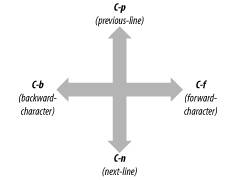Книга: Learning GNU Emacs, 3rd Edition
2.1 Moving the Cursor
The easiest way to move the cursor is to click the left button on your mouse or to press the arrow keys. However, it's a hassle to reach for a mouse all the time. Learn to use keyboard commands to move around so that you will ultimately achieve blinding speed and maximum productivity in Emacs.
To use Emacs commands to move the cursor forward one space, type C-f(f for "forward"). As you might guess, C-b moves the cursor backward. To move up, type C-p (for previous-line), and to move down, type C-n (for next-line). It's easier to memorize commands if you remember what the letters stand for.
Figure 2-2 illustrates how to move up, down, left, and right using Emacs commands.
Figure 2-2. Basic cursor motion

If you're at the end of a line, C-f moves to the first character on the next line. Likewise, if you're at the beginning of a line, C-b moves to the last character of the previous line. If there's no place to go, Emacs beeps and displays the message Beginning of buffer or End of buffer.
- 2.1.1 Other Ways to Move the Cursor
- 2.1.2 Moving a Screen (or More) at a Time
- 4.7.2 Moving to a Bookmark
- 7.6.2.1 Cursor motion in picture mode
- 4.4.4 The Dispatcher
- About the author
- Chapter 7. The state machine
- Appendix E. Other resources and links
- Example NAT machine in theory
- The final stage of our NAT machine
- Compiling the user-land applications
- The conntrack entries




